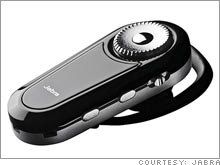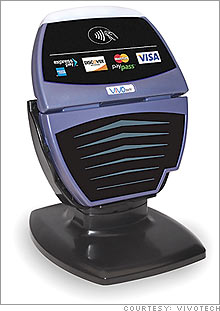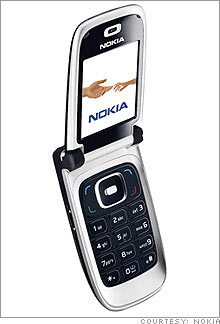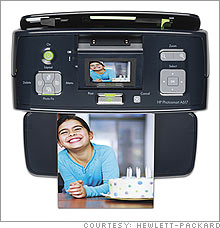A new version of the wireless technology will soon allow consumers to beam photos from cameras and use their cell phone to make purchases, reports Business 2.0 Magazine.
(Business 2.0 Magazine) -- There are a billion Bluetooth-enabled devices in the world -- cell phones, headsets, cameras, keyboards, printers. Another 13 million of them are being sold every week.
But that's chump change compared with the growth that analysts expect to see once a new version of the short-range wireless technology makes its way into products later this year.
 |
| SOUND SOLUTION: The updated Bluetooth standard also means easier pairing with headsets like this one from Jabra. |
 |
| ON THE MONEY: The new Bluetooth lets cell phones make payments via special readers at cash registers. |
 |
| THE BLUE YONDER: Nokia's 6131 NFC, coming soon to the States, will be one of the first handsets to feature Bluetooth 2.1. |
 |
| CLEAR PICTURE: Printers like this HP model will seamlessly pump out snaps from your phone. |
Here's why: Pairing up Bluetooth devices is a laborious process that requires as many as 15 steps.
"The most significant challenge that Bluetooth has faced is making the technology more usable, especially when it comes to setting up connections," says Stuart Carlaw, an analyst with New York-based ABI Research. "There is no doubt that there are more viable business models for the technology. They just need to be better supported at the most difficult point" in the user's experience.
That should happen this fall, when the first Bluetooth upgrade in three years, Bluetooth 2.1, starts shipping.
Devices will be paired in as few as three clicks. Encrypted data transfer means no need for passwords. And lower power consumption means that Bluetooth 2.1 devices will have as much as five times the battery life of their predecessors.
All of which means that mass-market Bluetooth use is expected to expand far beyond the cyborg-style phone headset.
Users will be able to easily beam photos from cameras to printers or digital picture frames. Wireless keyboards, mice, and videogame controllers will get a boost too. Bluetooth 2.1 will be integrated with near field communication, or NFC, a standard for mobile payments, so consumers will have more opportunities to pay with their phones.
Companies like Jabra, Motorola (Charts, Fortune 500), and Plantronics (Charts) are developing Bluetooth 2.1 gadgets that should be out in time for the holiday season. The Bluetooth Special Interest Group -- a consortium backed by Intel (Charts, Fortune 500), Microsoft (Charts, Fortune 500), and Nokia (Charts) -- says the number of Bluetooth devices in the world should double to 2 billion by 2010.
"Clearly, one of the goals of the new specification is to drive use of the technology and help our members sell more products," says Kevin Keating, senior marketing manager at the Bluetooth SIG.
Sales of Bluetooth headsets alone, now at $8 billion, are expected to hit $14 billion within three years -- aided by an increasing number of bans on driving while talking on handsets. Such bans will go into effect in states like California and Washington by next year, creating millions of potential new headset customers.
"So far, the pairing aspect has been a barrier to entry compared with headsets that you plug into the phone," says Peter Hartmann, global product manager at headset maker Jabra. "Now it will be much easier for first-time users."
In 2008, Bluetooth 2.1 will itself be replaced by Bluetooth 3.0, code-named Seattle. That version is expected to integrate ultra-wideband technology, meaning Bluetooth that can handle the transfer of much larger amounts of data: Seattle should be a whopping 228 times faster than its predecessor.
Bluetooth's supporters expect that upgrade to have a major impact in the entertainment and consumer electronics industries, since it will enable users to transfer video between TVs and cell phones.
Even Hollywood is going blue
